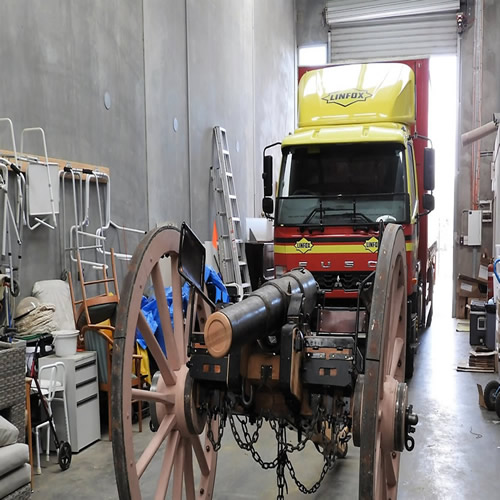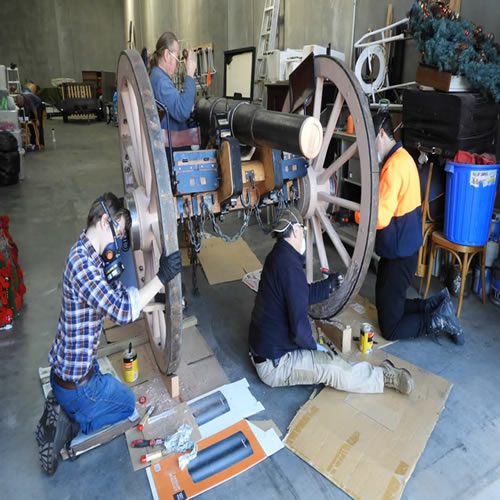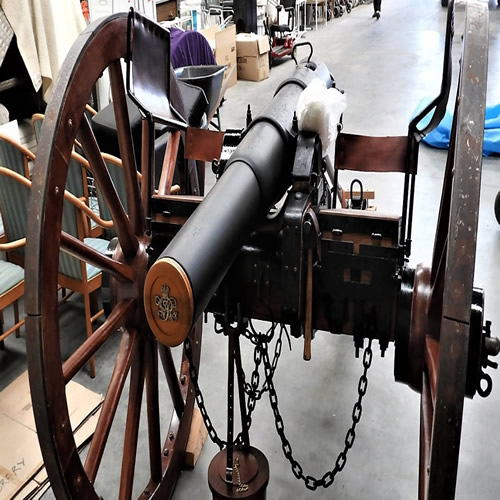|
||||||||||||||||||||||||||||||||||||||||||||||||||||||||||||||||||||||||||||||||||
| Have a Question / Feedback ? | Submit- only questions about this website will be answered | Search Our Site |
|
|
||||||||||||||||||||||||||||||||||||||||||||||||||||||
|
||||||||||||||||||||||||||||||||||||||||||||||||||||||
| I had been interested in the future of this gun since 2003 and had originally approached the AWM and Parks Victoria Werribee Park, about the future of the gun and the possibility of returning the gun to Werribee and restoring it. The AWM sent me their curatorial guidelines for the restoration of Armstrong 370, but no further progress could be made at that time as Parks Victoria did not have any areas suitable to conduct a restoration or any personnel. In 2014 while searching for a suitable period gun which could be utilised by the newly formed Werribee Half Battery, I became aware that the RAAHC had gun 370. Their Collection Manager, Kevin Browning, advised me that there were no funds to restore it and whilst they had the volunteers capable of doing the timber work; the timber they had was ironbark and totally unsuitable due to its weight and hardness. I offered to try to source a suitable timber and secure funding for it. Discussions with various custom timber suppliers revealed that the only timber available in the size required was Golden Cypress, which is milled in Victoria from old Golden Cypress removed from country properties by Golden Cypress Timber Sales. Kevin provided details of the quantity and dimensions of timber required in July 2015. The cost of such timber would be $1760. I approached the Royal Australian Artillery Association Victoria and met with LTCOL Jason Cooke and MAJ Neil Hamer (Ret), then secretary and president respectively of the Association, with the restoration proposal. This was taken to their committee and a $2000 grant was approved. |
||||||||||||||||||||||||||||||||||||||||||||||||||||||
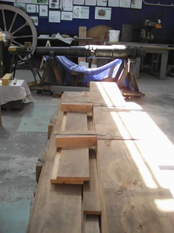 |
In August 2015 my wife Maryanne and I met with LTCOL Jason Cooke at the Werribee RSL. At this meeting LTCOL Cooke, in his role as a Director of the RAAHC, offered me appointment as the project manager for the restoration. I was initially hesitant as the restoration was being carried out in Sydney, but he assured me that as it was a management role it could be done from Melbourne by way of e-mail and telephone. After some consideration and the support of my wife, I advised him the next day of my acceptance of his nomination and I was duly appointed by the Board.
Significant additional funds were still required. Quite a few metal components had to be fabricated, the most significant and costly of these being the trail plates and towing eye. There was a problem finding a manufacturer willing and capable of doing the work and at a reasonable price. Commercial enquiries were met with an inability to do the job, no time or interest in doing so or extremely expensive quotes of tens of thousands of dollars. My enquiries with various blacksmiths in Melbourne led me to Stephen Nicoll, recommended as the only blacksmith capable of doing the job, as he had access to a steam hammer which he had restored and electrified. Steve agreed to take on the job and at an affordable price. |
|||||||||||||||||||||||||||||||||||||||||||||||||||||
| Arrival of the timber at North Head February 2016. In the background note the barrel, axle, and one of the wheels. Photo: K. Browning | ||||||||||||||||||||||||||||||||||||||||||||||||||||||
| All up it was estimated that we required a $10,000 budget to complete the restoration and so I sought an additional $8000 through the Federal Governments Building Stronger Communities Grant scheme with the full support of local Lalor Federal member Joanne Ryan and her office in April 2016. This grant application was successful, the RAAHC being notified in June 2016 and this provided sufficient funds to complete the structural work. The RAAHC Board had previously agreed to a request to provide the gun on long term loan to the Werribee Half Battery which was critical to the relevance and success of the grant. The gun would remain on loan until required for display at the proposed Australian Army Artillery Museum at Puckapunyal. | ||||||||||||||||||||||||||||||||||||||||||||||||||||||
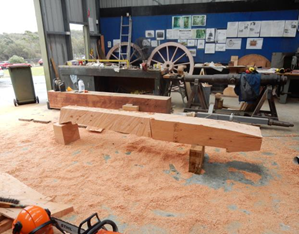 |
The Golden Cypress timber had been cut to the size specified and delivered direct to North Head, Sydney in February 2016. With the support of the Sydney Harbour Federation Trust, volunteers at North Head then commenced work. All the timber work had to be rebuilt, except wheels, and a quantity of the metal pieces fabricated. The first challenge facing chief carpenter Bill Stuart was how to cut and shape the huge 3 metre long Cypress beam. The restoration of the Hastings 40 pounder Armstrong had used a huge bandsaw to do the shaping, however my enquiries were unable to locate any company with a saw capable of doing the job.,including boatbuilding companies in Tasmania.
Bill Stuart suggested using somebody very experienced with wood shaping using a chainsaw. Whilst initially aghast at the suggestion, I recall having seen carvings done with chainsaws. Bill knew such an expert chainsaw exponent, David Taylor, who was quite confident of being able to perform the work required and was duly engaged to do so. Once reduced to the general shape the accurate finish could be obtained using electric planes and other hand tools. |
|||||||||||||||||||||||||||||||||||||||||||||||||||||
| Chainsaw wood shaping completed.Note the orginal iron bark beam which was to be used in the background Sept 2016 | ||||||||||||||||||||||||||||||||||||||||||||||||||||||
 |
In Melbourne, blacksmith Steve produced all of the blacksmith forged pieces required, the most significant of those being the trail plates and towing eye. Steve found this quite a challenge due to the large size and weight of the pieces but with perseverance and determination he produced the required pieces which were fitted and came together beautifully on the wooden trail. Producing the trail plates was even more challenging because he was often working from templates sent down by Bill. With respect to other pieces and the general construction of the gun carriage, it soon became apparent the engineer drawings were not accurate but a visit by Kevin and Bill to the AWM allowed necessary checks to be made. |
|||||||||||||||||||||||||||||||||||||||||||||||||||||
| Trail Plates being fitted Nov 2017 | ||||||||||||||||||||||||||||||||||||||||||||||||||||||
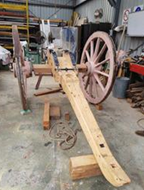 |
In other instances, references had to be made to sections of the original plans which we had, to resolve the inaccuracies, inconsistencies and contradictions in the engineer drawings supplied to the AWM. A simple and obvious example here relates to the traversing lever.
There is a forked section at one end which is meant to fit over the azimuth nut which moves along the traversing screw. The width of the fork into which the azimuth nut fitted was less than the dimensions of the nut. Reference to the original plans confirmed what was obvious and consistent with the dimensions of the azimuth traversing nut. North Head assisted with metal work, for example, the axle made for the AWM was too long and had to be reduced, using a cut and shunt method. Bill also found some spare time at home to produce all of the leather work and the bucket. He also roughed out the trail spike using a piece of naturally shaped fig timber, which Steve Nicoll completed in Melbourne. |
|||||||||||||||||||||||||||||||||||||||||||||||||||||
| Gun carriage takes shape Aug 2018 | ||||||||||||||||||||||||||||||||||||||||||||||||||||||
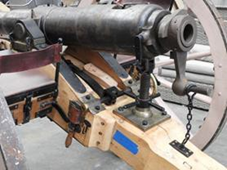 |
The engineering team at North Head also manufactured all the non blacksmithing structural steel work required. It is not possible here to clearly show the expertise all these volunteers have provided but the tolerances they had to work to were very fine in many places and they met every one. Special credit and thanks must be given to Bill Stuart, the carpenter craftsmen with Steve Hassett, engineer, who built the carriage and to blacksmith Stephen Nicoll for the major pieces he crafted in Victoria. |
|||||||||||||||||||||||||||||||||||||||||||||||||||||
| View of the breech, elevation and traversing mechanism with azimuth nut | ||||||||||||||||||||||||||||||||||||||||||||||||||||||
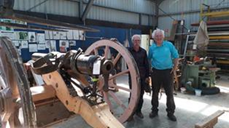 |
There was pressure on Bill Stuart and the team in Sydney to complete the structural restoration asthe shed being used for the work was required by the Sydney Harbour Federation Trust. The building was supposed to be vacated by the end of 2018, however we were able to gain an extension to allow the structural work to be completed. As project manager, I was aware of this situation and looked for a site in Werribee to store the gun and complete the surface finishing.In December 2018 I became aware that the Werribee RSL subbranch had a storage facility and approached the memorabilia officer Merv Clifton on this matter. He took this to the committee and the committee consented to 370 being stored there. The next challenge was to transport the Armstrong to Melbourne. |
|||||||||||||||||||||||||||||||||||||||||||||||||||||
| Steve Hassett and Bill Stuart fit the barrel to check their work, Sept 2018 | ||||||||||||||||||||||||||||||||||||||||||||||||||||||
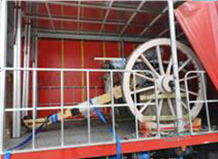 |
The Fox Family Foundation had been major supporters of the RAAHC 18 pounder project, so I made a formal approach to them to assist with transport. Within 24 hours of my written request being received, it went before Lindsay Fox .
The following day I received a call from the State Transport Manager saying that Linfox transport would provide transport for the gun from Sydney pro bono. We are very thankful to Lindsay Fox, the Fox Family Group and Linfox transport for their support. On 29 April 2019 a suitable heavy rigid Linfox (Bevchain) truck with a large rear lifting platform was dispatched to Sydney and the following day the Werribee Gun was loaded onto the truck and safely secured for transport back to Werribee. |
|||||||||||||||||||||||||||||||||||||||||||||||||||||
| Gun No 370 safely stowed away | ||||||||||||||||||||||||||||||||||||||||||||||||||||||
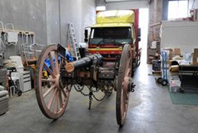 |
On 1st May the Werribee gun arrived back in Werribee after an absence of 126 years. | |||||||||||||||||||||||||||||||||||||||||||||||||||||
| Gun No 370 Safely back at Werribee | ||||||||||||||||||||||||||||||||||||||||||||||||||||||
 |
It was now the task of the Werribee Half Battery Living History Group under the guidance of the Project Manager, to complete the restoration which meant removing the paint from the wheels, staining and varnishing the carriage and preserving the metal work. The first step in finishing the carriage was to remove the pink primer from the wheels. This was a massive and difficult job as there was a thick layer of pink primer. Initially after using a lot of paint stripper with wire brushes and scrapers the bulk of primer was removed. The next step was sanding the remaining primer off using orbital and detail anders. The lesson learnt here for everyone is never ever paint any wooden surface that might conceivably be varnished and stained at some stage in the future! The wheels and hubs were found to be made of Jarrah, with Spotted Gum used for the spokes. |
|||||||||||||||||||||||||||||||||||||||||||||||||||||
| WHB members Ben Cook, Carl Sarelius, and Sam Jaeger hard at work on paint stripping. Steve Nicoll at the breech | ||||||||||||||||||||||||||||||||||||||||||||||||||||||
 |
During this time blacksmith Steve Nichol forged the rammer cleat on site with his portable forge and anvil to exactly fit the contour of the rear of the trail. The staining and varnishing were completed by mid-November 2019 and in late November the Werribee Half Battery attended the venue for promotional pictures with the gun. However, by this time restoration funds were exhausted and additional funding estimated at $4000 was still required to complete the project, significant items remaining being the trail spike, drag shoe, commemorative plaque(s), completion of the spare tangent sight and barrel finishing costs. Kevin Browning and myself sought additional funds. Kevin was successful in obtaining a donation from 131 Locators Association Inc. with the Board of the RAAHC allocating the balance. |
|||||||||||||||||||||||||||||||||||||||||||||||||||||
 |
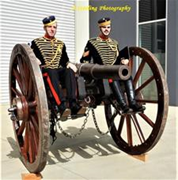 |
|||||||||||||||||||||||||||||||||||||||||||||||||||||
| Michael and Roman Absolon with Allan Sterling at the completion of the staining, 5 Nov 2019 | James Henderson and Benjamin Casey demonstrate the use of the axle seats | |||||||||||||||||||||||||||||||||||||||||||||||||||||
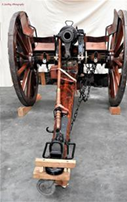 |
The next challenge was the improvement of external appearance of the barrel and cleaning the interior. The main problem with the external barrel finishing was an extremely inconsistent surface. Part of the patina was the grey appearance of aged iron; other sections were rusted; there were significant dings and pitting and other sections had a black appearance which was either old paint or some type of blueing. It is very difficult to get uniform satisfactory results with such an inconsistent surface. Our first attempt was to use a rust converter, which in theory and in testing, converted rust to a black phosphate finish. However, when we attempted this it was not at all successful, probably due to the condition of the surface or the fact that treatment is designed for steel not iron. Ideally, we could have gone for a browned finish but with the variability of the surface the whole barrel would have to be removed, cleaned and then browned. We did not have the lifting facilities to remove the barrel from the carriage and even after cleaning and browning, there was no guarantee that the process would be successful. It would also have added significant expense to the restoration. The only viable alternative was to paint the barrel in flat or satin black. The Deniliquin Armstrong Gun number 368, one of its sisters, has its barrel painted and presents well. . The Australian War Memorial’s gun number 367 has a pleasing browned finish but was in very good condition to start with. Painting, however, presented a major problem. Spray-painting is the ideal way to get a good finish but as we could not remove the barrel from the carriage the risk of overspray onto an already finished gun carriage is great and so was not a viable way to go. |
|||||||||||||||||||||||||||||||||||||||||||||||||||||
| Presentation ready | ||||||||||||||||||||||||||||||||||||||||||||||||||||||
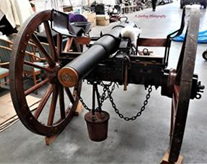 |
The barrel interior was in extremely poor condition. A Melbourne brush manufacturer was located who advised on and produced a custom steel chimney flue brush of the correct diameter. This resembled an overgrown version of the normal coiled wire brush one would use in a rifle. We also made disposable lambswool covers which could be used to mop out the barrel. Our first attempts at using the wire brush bought out a mass of flaking rusted iron.
Graduallyafter repeated runs and a lot of WD 40, the barrel has cleaned out fairly well. My thanks to Michael and Roman Absolon for their persistence and expertise in this operation. The rifling is generally intact. There is one section of the barrel where it is obvious that paper or other material had been lodged while it was on display in the park and water had accumulated there resulting in significant pitting and the destruction of the rifling in that area. However, the barrel will be quite safe for blank firing. |
|||||||||||||||||||||||||||||||||||||||||||||||||||||
| Presentation ready, front view 8 July 2020 |
||||||||||||||||||||||||||||||||||||||||||||||||||||||
At the time of writing in late August 2020, the next challenge is to make the gun available for public display and utilisation by the Werribee Half Battery. The most appropriate location for display is Werribee Park, ideally the farm area where suitable carriage sheds exist. This is in an area immediately above the Werribee Golf Course originally called Military Flat, where artillery and small arms training was carried out by the Half Battery in the 1890s. This matter will be subject to discussions with Parks Victoria. It is intended that the Werribee Gun will be blank firing and can be deployed by the Werribee Half Battery for ceremonial and training purposes. Blank firing requires the construction of a custom powder cartridge which has already been produced and a mechanical ignition system, yet to be produced, as friction tubes are not available. When the Corona virus situation is resolved we look forward to officially unveiling the Werribee Gun. My sincere thanks as Project Manager, to all those involved in realising the long-awaited restoration of this significant piece of Australia's artillery history. Appendix 1 Technical details: Type: Armstrong 12 pounder rifled breech loading (RBL) field gun Model: 1859Manufacture: Royal Gun Factory, England, 1864 Serial number: 370Calibre: 76mm (3 inch) Markings: Crest of Queen Victoria and weight forward of the breech, serial number, manufacturer and year on the left trunnion, Marshall’s Iron on the muzzle Rifling: 38 lands Twist of rifling: 1 in 38 calibres Weight: Barrel –432kg (8cwt 2 qtrs), carriage – 610kg (12cwt) Barrel length 1829mm (72 inch) Maximum range: 3050m (3340 yds) Elevation: 10 degrees (Maximum) Traverse: 2.5 degrees left or right Muzzle velocity: 378 m/s (1240 ft/s) Projectile weight: 5.4kg (12lb) Rate of fire: Approx. 1 round/min. This type of gun was:
The barrel is rifled and the gun has an accurate range of 1800 m (2000 yards). Loading is through the screw breech with a projectile and cartridge. The breech is closed by the insertion of the vent piece and then sealed by winding in the screw, which locks the mitred faces of the vent piece and breech recess. It was fired using a friction tube inserted into a touch hole in the vent piece. The Gun Detachment (Gun Crew): As laid down in the Artillerist’s Manual 11th Edition 18682, nine active members are required to operate the gun in the field. The original Werribee Half Battery used a seven-man gun detachment, categorised as active numbers with additional members being three horse holders and three drivers3. However, the gun could be operated with the reduced detachment with the Manual also specifying the duties carried out by four, three, and as little as two active members. Certainly, once the gun is in position it can effectively, though slowly be operated by two members. The contemporary Werribee Half Battery will use a four-man detachment. The gun can effectively be moved by four-men, but is quite difficult to manoeuvre due to its weight with less than four men. A brief history of the Werribee gun and Victoria's Armstrong guns by Kevin Browning, OAM The gun was designed by the British manufacturer W A Armstrong and entered service with the Royal Artillery in 1859. Victoria ordered six of these guns in 1861 and these were given to the Royal Artillery in 1863 for use in New Zealand. Replacements were ordered and arrived in January 1865 and used by the Metropolitan Artillery Corps of the Victorian.Volunteer Artillery. In May 1880 twelve members of the Permanent Victorian Artillery under the command of Captain Anderson and a 12-pounder 8 cwt RBL gun were dispatched by special train from Melbourne to Glenrowan4. It was intended to use the gun to blow down Jones’ hotel if the Kelly Gang did not surrender. Before they arrived the siege was over and the train was stopped at Seymour and returned to Melbourne. In 1885 the Victorian Government purchased new 12-pounder breech loading guns and the old RBL guns were placed in storage. In February 1889 Andrew Chirnside, a wealthy landowner, offered to contribute to a half battery on similar grounds to the Nordenfelt Battery raised by Sir William Clarke, Bt in 1884. The Government decided to combine the two half batteries, Clarke’s Rupertswood half battery and Chirnside’s Werribee Park half battery became the Right Half Battery and Left Half Battery of the Victorian Horse Artillery. The Werribee Half Battery was commanded by Andrew’s youngest son Lt (later Capt.) Percy Chirnside. Each half battery was provided with two (later three) old 12-pounder RBL guns which the Government promised to replace with more suitable guns as soon as these could be identified.Andrew Chirnside died in April 1890 and with the economic downturn of the 1890s his son George wrote to the Government in December 1892 seeking to be relieved from his father’s commitment. Consequently, the Werribee Half Battery was disbanded on 1 March 1893. Following the death of Sir William Clarke in May 1897 his son, Sir Rupert Clarke spoke with the Minister of Defence regarding the maintenance of the battery. As the Government was not prepared to incur the cost of supplying modern guns he announced he intended to discontinue his family’s contribution to the upkeep of the battery and subsequently the Government disbanded the unit from 30 June 1897. In October 1897, in recognition of the contribution Sir William Clarke had made to the defence of Victoria, the Government presented to Lady Clarke two of the 12-pounder guns. Two other guns were in poor condition and it is assumed the other two found their way to the Chirnside family. Photos credits: Unless otherwise credited, all photos at North Head compliments Peter Lawrence. All Werribee pictures by Allan Sterling.
Notes and references: |
||||||||||||||||||||||||||||||||||||||||||||||||||||||
Everywhere Whither Right and Glory Lead |
||||


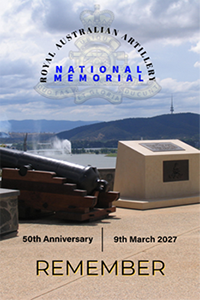
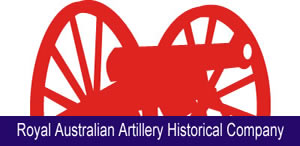

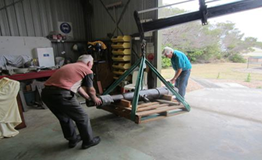

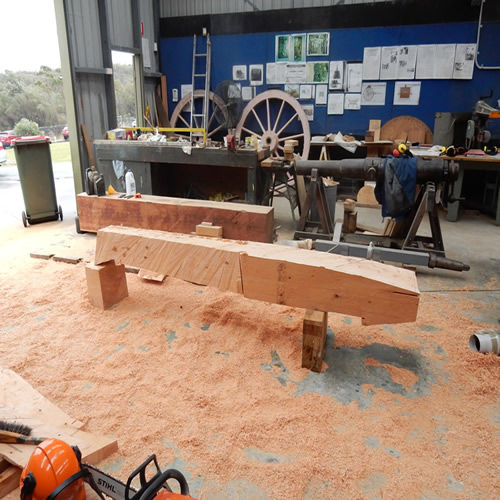

.jpg)

